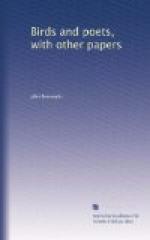There is something almost pathetic in the fact that the birds remain forever the same. You grow old, your friends die or move to distant lands, events sweep on, and all things are changed. Yet there in your garden or orchard are the birds of your boyhood, the same notes, the same calls, and, to all intents and purposes, the identical birds endowed with perennial youth. The swallows, that built so far out of your reach beneath the eaves of your father’s barn, the same ones now squeak and chatter beneath the eaves of your barn. The warblers and shy wood-birds you pursued with such glee ever so many summers ago, and whose names you taught to some beloved youth who now, perchance, sleeps amid his native hills, no marks of time or change cling to them; and when you walk out to the strange woods, there they are, mocking you with their ever-renewed and joyous youth. The call of the high-holes, the whistle of the quail, the strong piercing note of the meadowlark, the drumming of the grouse,—how these sounds ignore the years, and strike on the ear with the melody of that springtime when the world was young, and life was all holiday and romance!
During any unusual tension of the feelings or emotions, how the note or song of a single bird will sink into the memory, and become inseparably associated with your grief or joy! Shall I ever again be able to hear the song of the oriole without being pierced through and through? Can it ever be other than a dirge for the dead to me? Day after day, and week after week, this bird whistled and warbled in a mulberry by the door, while sorrow, like a pall, darkened my day. So loud and persistent was the singer that his note teased and worried my excited ear.
“Hearken to yon pine warbler,
Singing aloft in the tree!
Hearest thou, O traveler!
What he singeth to me?
“Not unless God made sharp
thine ear
With sorrow such as mine,
Out of that delicate lay couldst thou
Its heavy tale divine.”
It is the opinion of some naturalists that birds never die what is called a natural death, but come to their end by some murderous or accidental means; yet I have found sparrows and vireos in the fields and woods dead or dying, that bore no marks of violence; and I remember that once in my childhood a redbird fell down in the yard exhausted, and was brought in by the girl; its bright scarlet image is indelibly stamped upon my recollection. It is not known that birds have any distempers like the domestic fowls, but I saw a social sparrow one day quite disabled by some curious malady that suggested a disease that sometimes attacks poultry; one eye was nearly put out by a scrofulous-looking sore, and on the last joint of one wing there was a large tumorous or fungous growth that crippled the bird completely. On another occasion I picked up one that appeared well, but could not keep its centre of gravity when in flight, and so fell to the ground.




